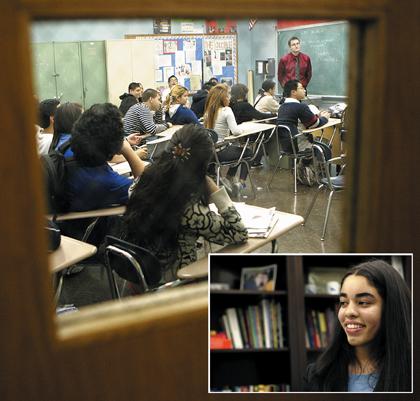By Jeremy Walsh
Look closely the next time you drive past 105-25 Horace Harding Expressway: A nondescript, stucco-covered, two-story building in faded formica blue next to the Long Island Expressway in Corona was the highest-ranked city school on Newsweek's 2008 list of the country's top high schools.
Arts and Business High School at was ranked 219th out of 1,358 schools that qualified this year.
The other Queens schools that made the list were Townsend Harris High School in Flushing at No. 327, Francis Lewis High School in Fresh Meadows at 558, Benjamin Cardozo High School in Bayside at 761, and Long Island City High School at 1,183.
Arts and Business made the list with a predominantly low-income student body and a substantial percentage of English language learners.
“It was a pleasant surprise,” said Principal Ana Zambrano-Burakov, noting the 767-student school also made Newsweek's 2006 list. “The students are always informed if the school does well.”
Arts and Business also scored an A in the first-ever school report cards issued by the city Department of Education last fall. Its art curriculum includes painting, sculpture, photography and video. Its business program includes a citywide marketing competition. This year Arts and Business students won the competition and saw their mock advertisement run in The New York Times.
Zambrano-Burakov said she is proud of her school's showing in the Newsweek list and the report card, but said she gauges success by a different rubric: an increase in the number of AP exams given and the number of students taking them.
The number of exams taken climbed from 225 in 2006 to 239 in 2007, and then to 258 in 2008. The number of students taking the tests went from 143 in 2006 to 140 in 2007, to 173 in 2008.
“Every year, we're going to try to expand it,” she said, noting next year the school hopes to add AP biology to the list of classes. “The important thing is to give students an opportunity to try… and not be afraid of the next step. If I only prepare them for a high school diploma, then I have not fulfilled my responsibilities.”
In the 2006-07 school year more than 92 percent of graduating students planned to attend college in the fall, according to the school's college guidance office. Most students went to the City University of New York, staff said, with others attending New York University, Penn State, Pace University and Fordham University.
Preparing students for college can be particularly difficult when there is a language barrier. Most of the school's students are from the predominantly Hispanic neighborhoods of Corona, Elmhurst and Jackson Heights, though the school is open to students across the borough. Some 17.8 percent are English language learners, according to the school report cards. In the 2005-06 school year, 4 percent of students were recent immigrants, DOE statistics show.
The best way to deal with this, Zambrano-Burakov said, is to focus on building students' working vocabularies.
“If a science teacher is teaching a concept and kids don't understand 'sequence,' it doesn't matter if he's the best teacher in the world. There's no comprehension,” she said. “We give exams and share data with the entire staff. If we think children are low in vocabulary, the entire staff knows. In a sense, they're all English teachers.”
Science lab teacher Jorge Franco said the school's small size and smaller classes leave him more time to help struggling students.
“Most people know each other,” he said. “We know students by name.”
Another impediment to academic success is poverty.
“The poverty level is very high among our students,” she said. “Parents often work two jobs to support their families. They can't help their kids pay for tutoring… so the responsibility of the school gets greater.”
She said the school holds weekend tutoring sessions during which it serves breakfast and lunch. Many students come for the meals and stay for the lessons, she said.
This year the school is also the recipient of a REACH grant, which pays students money for passing scores on their AP tests. A score of 3 will pay $500, a 4 will pay $750, and a score of 5, the highest, pays $1,000.
“Since this is a low-income school, many students have part-time jobs that can be time-consuming,” she said. “Now if they study, they get paid.”
The money is not earmarked for tutoring or supplies, she said, so students are free to use it for the same things as a paycheck.
Another major strategy the school employs is to interview students one-on-one, both while they are still in intermediate school and during a two-day orientation session the summer before freshman year.
“If we see a literacy problem, we double them up on English,” she said. “If we see a math issue, we double them up on math.
Corona resident Stephanie Solaris, 17, a senior and student body president, said she initially had problems with math. The school doubled her math classes during her freshman year — not the most pleasant experience but effective.
“It was in the morning and it was horrible, but now I'm in calculus,” she said.
Stephanie's social anxiety was also relieved by the friendly atmosphere, she said.
“When I came here, no one else from my school was here. It was scary, because I didn't know anyone. But the teachers, staff and kids were really friendly. I felt right at home.”
Reach reporter Jeremy Walsh by e-mail at jwalsh@timesledger.com or by phone at 718-229-0300, Ext. 154.































